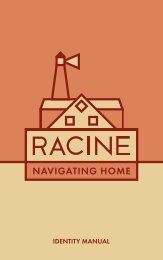Artful Magazine
Artful is about the subtle art, creativity and expression in daily life—the art in you, your environment, to your community. Student Work | Magazine Layout
Artful is about the subtle art, creativity and expression in daily life—the art in you, your environment, to your community.
Student Work | Magazine Layout
You also want an ePaper? Increase the reach of your titles
YUMPU automatically turns print PDFs into web optimized ePapers that Google loves.
Left: Wall textures
on the Hamel Music
Center in Madison.
Center: Shields
poses for a photo in
her apartment.
Right: A mural of a
face looks out from
the Berlin Wall in
Berlin, Germany.
with the medium (for example, composers who must
compose at the piano, painters who must “play about”
in the medium in order to get painterly ideas), and others
prefer to create in their minds only (Mozart, it is said,
visualized every note in his mind before he wrote the
score). There appears to be no true generalization that
can be made about the process of artistic creation—certainly
not that it is always a process of expression. For
the appreciation of the work of art, no such uniformity,
of course, is necessary, greatly though it may be desired
by theorists of artistic creation.
The main difficulties in the way of accepting conclusions
about the creative process in art are (1) that artists differ
so much from one another in their creative processes that
no generalizations can be arrived at that are both true
and interesting or of any significance and (2) that in the
present stage of psychology and neurology very little is
known about the creative process—it is surely the most
staggeringly complex of all the mental processes in human
beings, and even simpler human mental processes
are shrouded in mystery. In every arena hypotheses are
rife, none of them substantiated sufficiently to compel
assent over other and conflicting hypotheses. Some have
said—for example, Graham Wallas in his book The Art
of Thought (1926)—that in the creation of every work of
art there are four successive stages: preparation, incubation,
inspiration, and elaboration; others have said that
these stages are not successive at all but are going on
throughout the entire creative process, while still others
have produced a different list of stages. Some say that the
artist begins with a state of mental confusion, with a few
fragments of words or melody gradually becoming clear
and the rest starting from there, working gradually toward
clarity and articulation, whereas others hold that the artist
begins with a problem, which is gradually worked out
during the process of creation, but the artist’s vision of
the whole guides the creative process from its inception.
Again, as to psychological theories about the unconscious
motivations of artists during creation, an early Freudian
view is that in creating the artist works out unconscious
wish fulfillments; a later Freudian view is that the artist is
engaged in working out defenses against the dictates of
the superego. Views based on the ideas of the 20th-century
Swiss psychologist Carl Jung reject both these alternatives,
substituting an account of the unconscious symbol-making
process. Until a great deal more is known about the
empirical sciences that bear on the issue, there is little
point in attempting to defend one view of artistic creation
against another.
YOU
9






